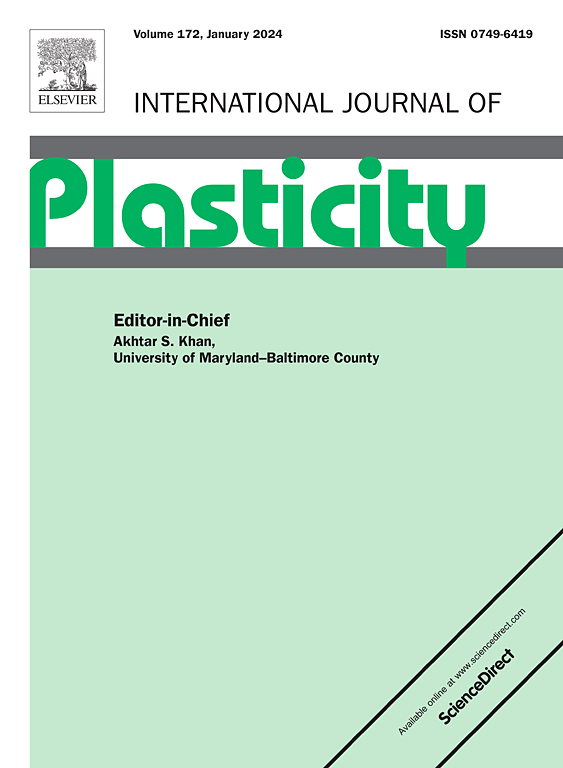Anomalous anisotropy in an additively manufactured solid-solution-strengthened superalloy from room to elevated temperatures
IF 12.8
1区 材料科学
Q1 ENGINEERING, MECHANICAL
引用次数: 0
Abstract
Metal additive manufacturing (AM) produces unique grain morphologies owing to the high cooling rates and large temperature gradients, which potentially lead to unexpected mechanical anisotropy. In this study, we unveil an anomalous anisotropic behaviour in a solid-solution-strengthened superalloy with periodic columnar-to-crescent grains fabricated by laser powder bed fusion (LPBF). Specifically, as-built (AB) specimens show higher strength perpendicular to the build direction (BD) than that parallel to the BD at room temperature (RT), while the opposite trend occurs at the elevated temperature (ET, 900 °C). Besides, the heat treatment eliminates the anisotropy of strength at both RT and ET. A dislocation-based damage-coupled crystal plasticity finite element (CPFE) model with strain gradients is utilized to understand the origin of the above anomalous anisotropy. It is found that the transition of anisotropy from RT to ET is attributed to the temperature-dependent dislocation annihilation combined with initial dislocations in AB state. In contrast to the heat-treated specimens without anisotropy, the LPBF-induced residual deformation primarily contributes to the anisotropy at RT, whereas the initial dislocations dominate the anomalous anisotropy at ETs for AB specimens. The CPFE model reveals the threshold temperature to be 600 °C for the occurrence of anomalous anisotropy, which is experimentally validated. This study presents a comprehensive understanding into temperature-dependent anisotropy of AM superalloys, and in turn guides the regulation of anisotropy by tuning microstructures.


增材制造固溶强化高温合金在室温至高温下的反常各向异性
金属增材制造(AM)由于高冷却速率和大温度梯度而产生独特的晶粒形貌,这可能导致意想不到的机械各向异性。在这项研究中,我们揭示了激光粉末床熔合(LPBF)制备的具有周期性柱状到新月形晶粒的固溶强化高温合金的反常各向异性行为。具体而言,在室温(RT)下,垂直于构建方向(BD)的建成态(AB)试样的强度高于平行于构建方向(BD)的试样,而在高温(ET, 900℃)下则相反。此外,热处理消除了RT和ET强度的各向异性。利用基于位错的应变梯度损伤耦合晶体塑性有限元(CPFE)模型来理解上述异常各向异性的成因。发现从RT态到ET态的各向异性转变是由温度相关的位错湮灭和AB态的初始位错共同作用的结果。与没有各向异性的热处理试样相比,lpbf诱导的残余变形主要导致了室温下的各向异性,而初始位错主导了室温下AB试样的异常各向异性。CPFE模型揭示了异常各向异性发生的阈值温度为600℃,并进行了实验验证。本研究提供了对AM高温合金的温度相关各向异性的全面理解,进而指导通过调整显微组织来调节各向异性。
本文章由计算机程序翻译,如有差异,请以英文原文为准。
求助全文
约1分钟内获得全文
求助全文
来源期刊

International Journal of Plasticity
工程技术-材料科学:综合
CiteScore
15.30
自引率
26.50%
发文量
256
审稿时长
46 days
期刊介绍:
International Journal of Plasticity aims to present original research encompassing all facets of plastic deformation, damage, and fracture behavior in both isotropic and anisotropic solids. This includes exploring the thermodynamics of plasticity and fracture, continuum theory, and macroscopic as well as microscopic phenomena.
Topics of interest span the plastic behavior of single crystals and polycrystalline metals, ceramics, rocks, soils, composites, nanocrystalline and microelectronics materials, shape memory alloys, ferroelectric ceramics, thin films, and polymers. Additionally, the journal covers plasticity aspects of failure and fracture mechanics. Contributions involving significant experimental, numerical, or theoretical advancements that enhance the understanding of the plastic behavior of solids are particularly valued. Papers addressing the modeling of finite nonlinear elastic deformation, bearing similarities to the modeling of plastic deformation, are also welcomed.
 求助内容:
求助内容: 应助结果提醒方式:
应助结果提醒方式:


